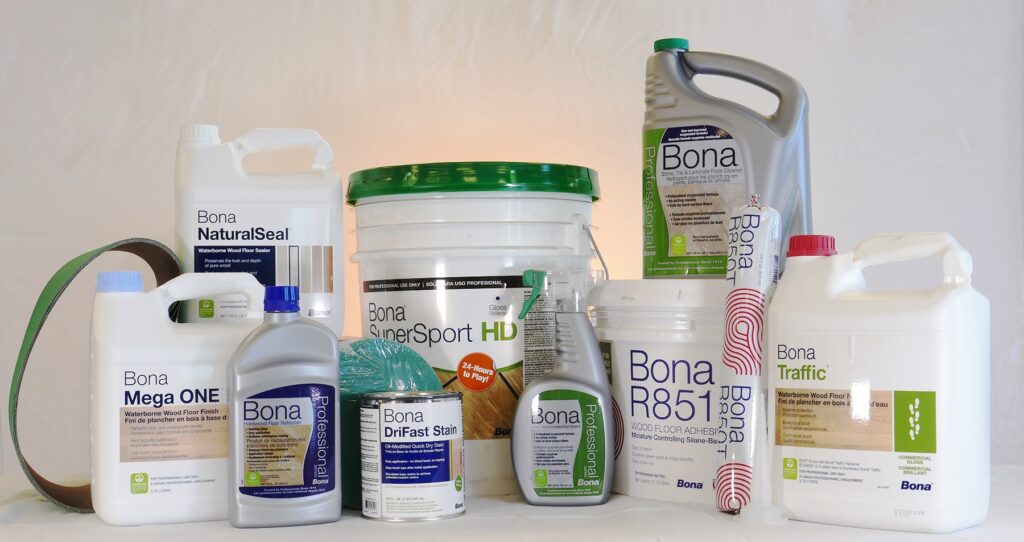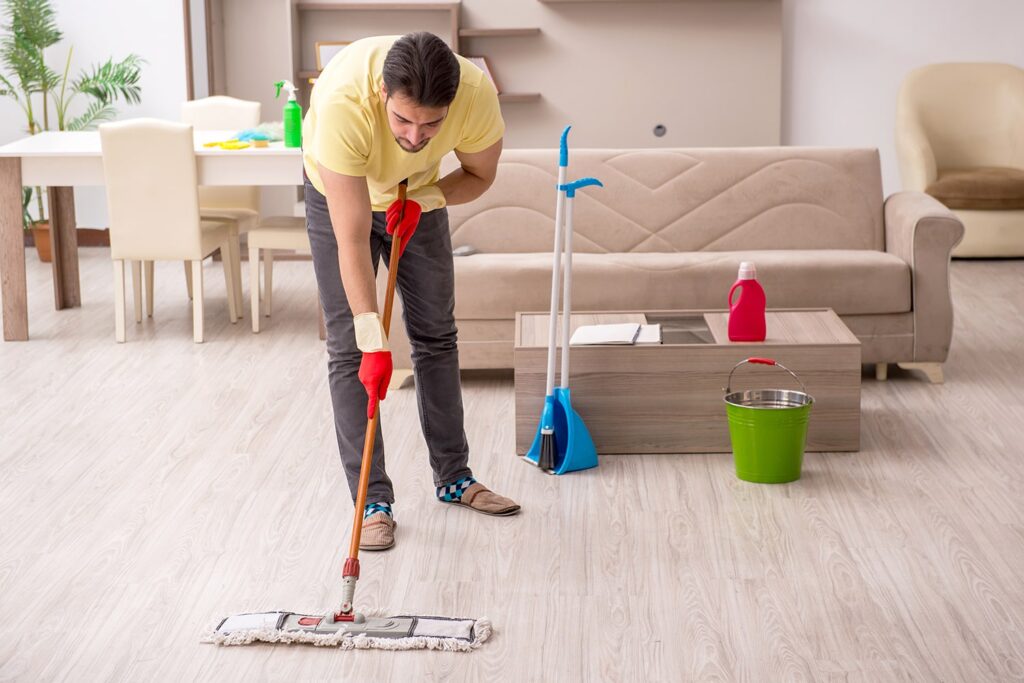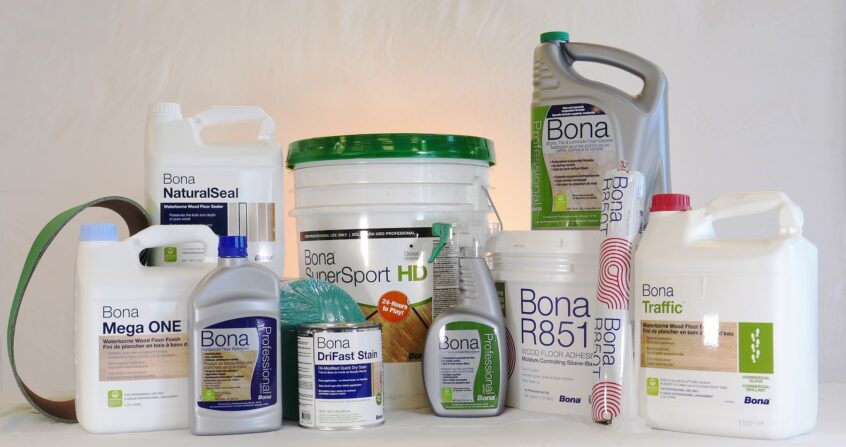Your urethane-coated engineered hardwood floor is very easy to maintain.
Use a quality wood flooring cleaner, such as those manufactured by Bona and a specialty cloth flooring mop available from flooring retailers.
NOTE: If your floor has an oil finish, check with your dealer or installer for appropriate maintenance products and procedures. These instructions are for urethane-coated hardwood floors.

Step One
Vacuum or sweep your floor to remove any particles that could scratch your floor. Warning: Vacuums with a beater bar or power rotary brush head can damage a wood floor and should never be used. Failure to vacuum or sweep your floor before using the dampened cloth to clean can result in “creating mud” on your floor which then can get trapped in the texture of your floor.
Step Two
Apply the cleaner directly to the cloth flooring mop. Do not spray the cleaner directly on the floor to avoid the wood absorbing the moisture. Spraying cleaner directly on the floor can also result in the cleaner drying on the floor and leaving a “milky haze” due to dried cleaner solids on top of the finish.
If a haze appears on your floor after a while due to dried solids on the finish you should clean your floor with reverse-osmosis or distilled water instead of a wood floor cleaner for your regular cleaning until the haze is gone. Reverse osmosis and distilled water have no dissolved solids (like calcium) that tap water can contain. These types of water should re-dissolve the solids dried on the floor, so the cloth can pick them up.
Some approved cleaners (like Bona) have mops that spray a fine mist of cleaner on the floor. These are fine as long as you do not apply too much liquid to the floor and the floor appears dry once done cleaning an area.
Step Three
Use a back-and-forth motion with the mop. When the cloth cover becomes soiled, simply replace it with a clean one. Cleaning the floor with a soiled mop cover could cause streaking.
Most mop covers are reusable, so simply throw the cover in the wash and dry it as you would any towel. Avoid using fabric softener as the absorbency will be reduced.
Common Cleaning Mistakes that can Void Your Warranty and Damage Your Hardwood Floor

Never wet your floor directly with cleaner or water.
Some cleaners have directions to “wet mop” the floor or apply cleaner liberally to the floor. This is not correct, and these cleaners or cleaning methods should not be used.
The exception to this is if the cleaner is approved (like Bona) and is applied in small amounts via a fine mist like the Bona Spray Mop.
Once your floor has been dust mopped or vacuumed you only need to spot-clean the areas that require it.
If you are cleaning the whole floor, always spray the mop head with cleaner. Wetting down your floor with cleaner can damage the floor if the wood absorbs excess moisture and it will cause the haze on your floor that was previously discussed. The flooring should not look “wet” when you are done cleaning an area. If it looks wet, you used too much liquid and did not pick up all the moisture with the back-and-forth motion.
Your flooring should look dry when done cleaning an area. If your floor looks wet after you have cleaned this means you have left moisture on the floor. The wood will absorb this moisture and expand, stretching the urethane finish. Then, when the wood loses this moisture it contracts, but the urethane finish cannot contract. This will weaken the bond between the urethane finish and the wood. Over time this repeated expansion and contraction due to excessive moisture during cleaning will break the bond between the wood and finish resulting in the finish peeling. This damage is not warrantable as it was caused by excessive moisture.
Never use a cleaner with oils: Some cleaners that describe themselves as hardwood floor cleaners contain oils (natural or otherwise). These oils can trap dirt in the texture of wire-brushed floors and then harden as it dries. This trapped dirt can be very tough to remove. Do not use cleaners with oils on textured hardwood; it is also best to avoid them on smooth hardwood.
Steam Mop Warning: Although steam mops are promoted by their manufacturers as being safe for use on wood floors, this is NOT THE CASE. The use of a steam mop can introduce excess moisture and heat into your wood floor. This can cause permanent damage. USE OF A STEAM MOP WILL VOID YOUR WARRANTY.
Humidity Levels for Your Hardwood Floor
To prevent excessive expansion, shrinkage, crackling or buckling of your hardwood floor it is important to maintain a humidity level for your area between 25% and 60% RH (non-radiant heated sub-floors) NOTE: If your flooring has a 4mm lamella (top layer) and a plywood core, the humidity levels should be 30%-65% RH (non-radiant heated sub-floors). See your dealer to help determine your lamella thickness. Use appropriate relative humidity control devices and monitor your relative humidity (RH) with a standalone hygrometer that has a humidity range of at least 10%-80% RH and is accurate to +/- 3% below 30% RH.
NOTE: The ThermoPro TP50 model hydrometer is an affordable hygrometer that is accurate in these ranges. Many hygrometers available at retail stores are not accurate below 30% and can give you a false sense of security. Make sure to check the technical specifications of the hygrometer before making your purchase.
Radiant Heat Sub-Floor Monitoring & Humidity
If you have a radiant heated sub-floor, you must maintain your humidity levels between 30%-60% RH as direct heat tends to drive some moisture out of wood. NOTE: If your flooring has a 4mm lamella (top layer) and a plywood core, the minimum humidity level for a radiant heated sub-floor application is 35%-65% RH.
The installer, home builder and homeowner should all have infrared thermometers to measure the surface temperature of the flooring to make sure it does not exceed 80F (27C) at any time. Note that the thermostats in your house do not measure the flooring temperature so do not rely on them to tell you how hot your floor surface is; instead, use an infrared thermometer. Infrared thermometers are relatively inexpensive and are available at most home improvement centers.
Hardwood Floor Protection
Water, dust, sand and salt are the worst enemies of wood. The combined effect of water and sand, salt or dust is devastating to flooring, so it is important to place floor mats at entrances. Install felt pads on the legs of furniture and chairs to avoid scratching flooring when objects are moved.
If you are using mats on your wood floor, do not use rubber-backed mats, as they will trap moisture and damage your floor. Use a breathable mat and honeycomb type of non-slip mat underneath so that air can circulate through the mat to the floor.
Sunlight
Normal exposure to sunlight will cause colour changes in any hardwood floor. Area rugs, which block out light, should therefore be shifted regularly. The use of window coverings to shade the floor will minimize changes due to sunlight.
Care Products
For best results, we recommend the use of specially formulated wood flooring cleaners and maintenance products such as Bona products. Note: Never use wax or household detergents on any engineered hardwood floor. Do not use oil-based soap on a urethane-finished floor. These products may damage the finish and leave a greasy film, making the floor slippery and difficult to maintain afterwards.
Need More Help?
Our team is always available to help you with your flooring maintenance questions; we supply flooring retailers with a variety of products, so can easily tell you exactly what you need, and where to get the products near you. Contact us today.


